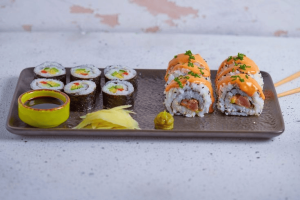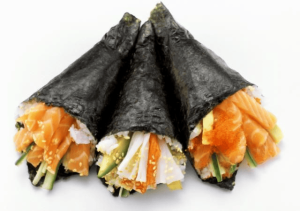Calories for Spicy Tuna Roll
The number of calories for a spicy tuna roll can vary depending on factors such as the size of the roll, the ingredients used, and the specific recipe. However, I can provide you with a rough estimate of the calories typically found in a basic spicy tuna roll.
A typical spicy tuna roll, which consists of rice, nori (seaweed), spicy tuna, mayonnaise, and sometimes other ingredients like cucumber or avocado, can contain approximately 250 to 300 calories per roll. Keep in mind that this is just an estimate, and the calorie count can be higher or lower depending on the specific ingredients and portion size used by the restaurant or when making it at home.
If you want a more accurate calorie count,calories for spicy tuna roll it’s best to refer to the nutritional information provided by the restaurant or the packaging if you’re buying a pre-packaged sushi roll. Additionally, homemade rolls may vary in calorie content based on the amounts of ingredients you use. Also, read about Green Apple Calories
Unraveling the Spicy Tuna Roll
What is a Spicy Tuna Roll?
The spicy tuna roll is a type of sushi roll made from a combination of fresh tuna, spicy mayo, cucumber, and sometimes other ingredients, all wrapped in a sheet of seaweed and rice.
The Ingredients
- Fresh Tuna: The star of the show, fresh tuna provides the rich, meaty flavor of the roll.
- Spicy Mayo: A blend of mayonnaise and spicy sauces gives the roll its characteristic kick.
- Cucumber: Cucumber adds a refreshing crunch to the roll.
- Seaweed: Nori seaweed is used to wrap the ingredients together.
- Rice: Sushi rice holds everything together and adds a subtle sweetness.
Understanding the Calories
Tuna’s Nutritional Profile
Tuna is packed with protein and healthy omega-3 fatty acids. It’s a nutritious addition to your diet, but it also contributes to the calorie count.
Spicy Mayo’s Caloric Impact
Spicy mayo can vary in calorie content depending on the brand and recipe. Its creamy texture and spicy flavor enhance the roll but also add to its calorie content.
Rice and Cucumber
While rice and cucumber are lower in calories individually, they still contribute to the overall caloric content of the spicy tuna roll.
The Average Caloric Content
An average spicy tuna roll contains approximately 290 to 350 calories. This can vary depending on the size of the roll, the amount of rice used, and the specific ingredients. Discover more What Does Coconut Water Taste Like

Exploring Sushi Beyond Spicy Tuna Rolls
Sashimi Delights
If you’re watching your calories for spicy tuna roll intake closely, sashimi is an excellent choice. It consists of thinly sliced raw fish, without rice or seaweed. This means you’re getting the pure flavor of the fish without additional calories from rice or sauces.
Vegetarian Options
Sushi isn’t just about fish. Many vegetarian rolls are available, incorporating ingredients like avocado, cucumber, and various veggies. These rolls tend to be lower in calories and are a great choice for vegetarians and calorie-conscious individuals.
Brown Rice Rolls
We mentioned it earlier, but it’s worth emphasizing again: choosing rolls made with brown rice can significantly reduce the calorie count. Brown rice is a whole grain that’s higher in fiber and nutrients, making it a healthier option.
Soup and Salad
Complement your sushi meal with miso soup and a side salad with a light dressing. These options add nutritional value without adding many calories.
Staying Informed at the Sushi Bar
Menu Knowledge
Don’t hesitate to ask your server about the ingredients and preparation methods of the sushi rolls.calories for spicy tuna roll Knowing what goes into your meal can help you make informed choices.
Sharing Is Caring
Consider sharing a variety of sushi rolls with friends or family. This way, you can sample different flavors without overindulging.
Condiment Control
Soy sauce and wasabi are common condiments for sushi. While they enhance the taste, use them sparingly, as they can be high in sodium.
Staying Hydrated
Sushi can be salty, so be sure to drink plenty of water to stay hydrated and help balance your sodium intake.

Making Healthier Choices
Lighten Up with Brown Rice
Opting for brown rice instead of traditional white rice can reduce the calories for the spicy tuna roll count of your spicy tuna roll. Brown rice is also higher in fiber and nutrients.
Portion Control
Enjoying a spicy tuna roll in moderation is key to managing your calorie intake. Consider sharing it with a friend or ordering smaller portions.
Customize Your Sauce
You can control the spiciness and calorie content by asking for less spicy mayo or opting for a lighter sauce.
Conclusion
In conclusion, calories for spicy tuna roll can be a delicious addition to your sushi experience. While it does contain calories, making mindful choices, such as opting for brown rice and practicing portion control, can help you enjoy this treat without guilt. Remember that sushi is not just about the calories; it’s also about the experience and flavors that make it special.
FAQs
1: Can I enjoy a spicy tuna roll if I’m on a diet?
Absolutely! By making smart choices like brown rice and portion control, you can savor a spicy tuna roll without derailing your diet.
2: Are all spicy tuna rolls equally high in calories?
No, the calorie content can vary depending on where you order it and how it’s prepared. Always check with the restaurant for their nutritional information.
3: Can I ask for a less spicy version of the spicy tuna roll?
Certainly, most sushi restaurants are accommodating and can adjust the spiciness according to your preference.
4: Is spicy mayo high in calories?
Spicy mayo can be calorie-dense, so be mindful of how much is used in your roll.
5: Are there any healthier alternatives to a spicy tuna roll?
If you’re looking for lower-calorie options, consider sushi rolls with more vegetables and lean protein like sashimi.
